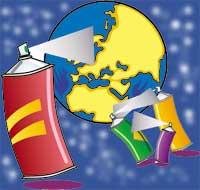After the Montrealdo pact...
Substances known as CFCs are anthropogenic chemical compounds used primarily in aerosols (such as propellants or sprayers), refrigerators such as bites or foams. They are inert in the lower part of the atmosphere and have no high toxicity. However, upon reaching the stratosphere they dissociate by the ultraviolet rays of the Sun, releasing chlorine molecules. These chlorine molecules severely affect the ozone layer. Each chlorine atom destroys thousands of ozone molecules that also last almost a century.
Therefore, these CFCs (along with other halogenated products) are directly responsible for a serious and dangerous thinning that is suffering stratospheric ozone layer. Why serious and dangerous? Because the ozone layer prevents the direct influence of ultraviolet rays, very harmful to the living beings of the planet. Therefore, as the ozone layer decreases, the situation of life on the planet, as we know it today, is worsening.
The damage caused by the disappearance of the ozone layer is so disproportionate that experts have not been able to calculate it correctly either. But harm is not something that can happen at some point, but what is taking place today, right now. According to recent studies in Antarctica, damage is already noticeable in animal genes, plant fertility and the development of phytoplankton, a fundamental eye in the marine trophic chain.

As for the damage caused to humans, it must be taken into account, according to data recognized by the United Nations, that the 10% decrease in the ozone layer in the world will generate 300,000 new cases of skin cancer each year. There is nothing more to see the increase so far experienced by the effects of skin cancers in recent times and everything points to an increase in the future. Don't forget that skin cancer is just one of the harms that ultraviolet rays can cause.
Since the signing of the Montreal Treaty, the theoretical ban on using CFCs has led to the use of HCFCs, alternative substances. The market left by the CFCs industry, especially in aerosols and refrigerants, is acquiring HCFCs. However, HCFCs are only cousins proper to CFCs, which to a lesser extent also cause a large impact on the ozone layer.
So why not definitely ban such dangerous and harmful products? Because companies do a round business with these products, of course. In Europe the use of these products will not be prohibited until 2014, while production will be allowed until 2030, do not forget that the Third World market is there, where the demand for these products is increasing.
Someone might think that HCFCs are used because there is no innocent product to replace CFCs. And I would be wrong, the truth is that the interests of companies like Elf (and I mean Elf in Bizkaia, in Zaramillo, because it has a workshop) are too big.
Cases like this (in my opinion, really criminal) reveal a motto like “who pollutes pays”. Is it enough to pay a fine if, despite fortune, the ozone layer continues to deteriorate? No, it is obvious. “The polluter must not pollute and cleanse the contaminated” is the correct philosophy.
Governments and companies do not solve anything considering the cost of fines in their budgets. Clean production must be addressed, that is, the uncontaminated production system, renouncing products that natural cycles cannot recycle.
Sustainable development cannot be an excuse to continue destroying the planet (if desired more slowly, but ultimately, to continue destroying). And that is the philosophy behind the substitution of substances: “Let’s continue to destroy the planet, but more slowly, because sustainable development demands it.” And as long as the conservative mentality behind this concept does not change, the planet and with it will continue to destroy our living conditions. The disaster will be sustainable, constant.
Buletina
Bidali zure helbide elektronikoa eta jaso asteroko buletina zure sarrera-ontzian











